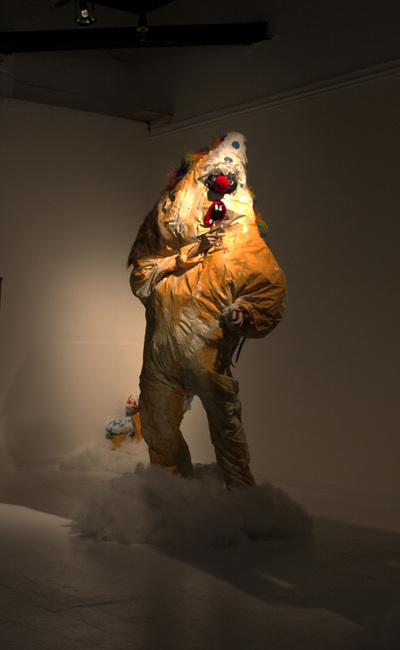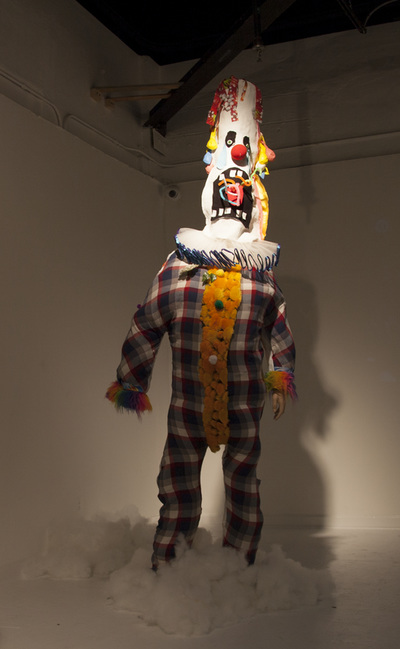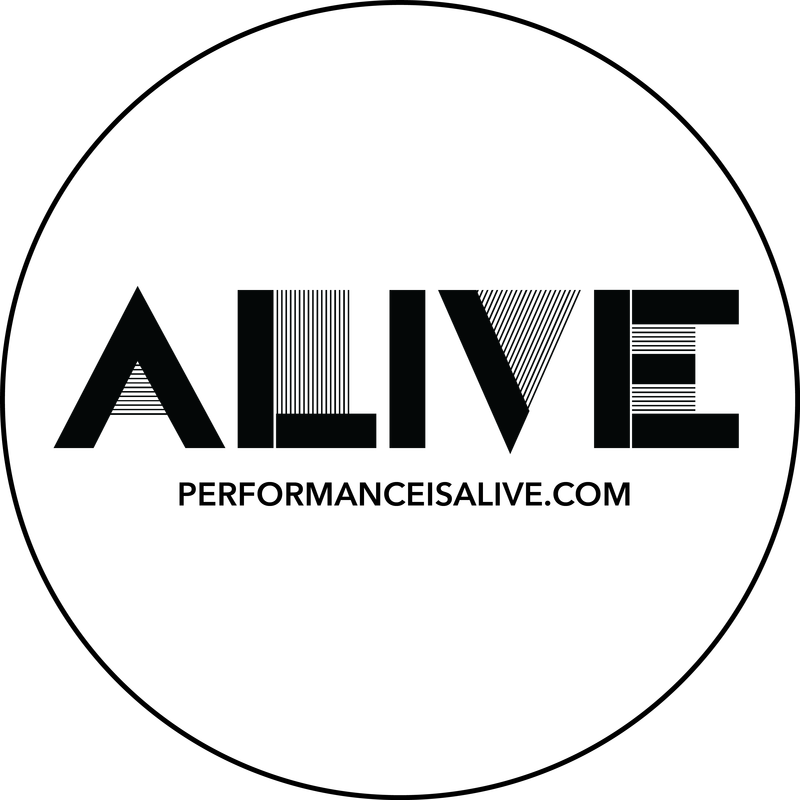|
Earlier this month Bakehouse Art Complex (Wynwood, Miami) premiered Brian Whiteley’s solo exhibition entitled Ghoulish Gestures. The exhibition was organized by guest curator Jesse Firestone. According to Firestone, Ghoulish Gestures is the result of multiple conversations with Whiteley about the reception and interpretation of his clown personas. Whiteley’s clown performances have enraged local communities across Chicago and Brooklyn, contributing to Youtube users naming Whiteley "the worst asshole ever"! Firestone also notes that “while Brian's impetus for these performances is noble - to show the people how easily the media can be manipulated- there is serious a breakdown in communication or translation because people are so enraged by the works that they can’t even see what his performances are doing. This gallery show presents a unique opportunity to remove the performances from their initial making, illuminate the inner workings that make these performances so viral-ready, and qualify them within a larger practice. It’s all about framing.” The presentation of performance art exhibitions can be incredibly challenging, especially without the presence of the live performer. I thought this was an excellent opportunity to hear directly from Whiteley about his performance interventions and am wildly excited to share our conversation with you. Ghoulish Gestures runs thru Tuesday, March 1st so if you are in or near Wynwood, Florida take the time to witness this wonderfully outrageous exhibition. (Bakehouse, Swenson Gallery, 561 NW 32nd St, Miami, FL 33127) - Quinn INTERVIEW WITH BRIAN WHITELEY QUINN DUKES: How do you bridge the gap between those who see your "absurdist" and "disrespectful" behavior as promoted via reporting with the true intention of the work? Do you think the individuals who respond with such incredible disdain later find the connection between the anonymous clown and you, Brian Whiteley the artist? Does this matter? BRIAN WHITELEY: I have no desire to bridge the gap between the public’s opinion and the motivation behind the work. For me, the beauty with this style of performance is that it lives on in a mythical form. The average person who reads the paper and watches the news is suddenly confronted with the idea that there are clowns haunting the local cemetery, or that Sasquatch may be in one of our parks. To me that is the best thing about the work. Few people connect the dots, and when they finally do they are typically thrilled to have found out the mystery. I like to think that no matter the response, the fact that someone had a moment to pause and reflect on something other than the daily grind, that I provided him or her with a moment of intrigue. QD: What led you to creating work within the crux of media hype and translation? BW: The origin of this work began several years ago when I was heavily into performing as Bigfoot. I would capture myself on video skulking through the woods, then send the footage into "professionals" (under a pseudonym) for their review. I'd conduct interviews with the crypto experts and learn as much as I could about their beliefs. I had dozens of conversations, people claiming that Bigfoot was a product of a fallen angel mating with a beast, people claiming that Bigfoot could turn himself invisible to avoid detection, people claiming that they knew other people living with Bigfoot, people claiming Bigfoot abducted them, etc. I would use these conversations as inspiration in my own studio practice where I dressed like Bigfoot and created art around the themes the experts disclosed. At a certain point I thought it was important that I speak with some Bigfoot hoaxers too, so I began reaching out to them as well. One hoaxer in particular still stands out, a mister Rick Dyer. Rick Dyer famously toured a fake Bigfoot body he created throughout the United States, stopping at various festivals and charging people money to see the corpse. He told me that he would make over $20,000 per stop. He consistently had huge lines at each festival; people were dying to see proof of Bigfoot's existence. Rick Dyer based his entire carnival sideshow on a similar stunt pulled in 1968 by a fellow named Frank Hansen. Hansen also toured a creature around the country to wide acclaim. Hansen’s gimmick involved a fake body in a block of ice that he called “The Iceman”. The intrigue was so great that the Smithsonian Institution even expressed interest in acquiring it. Inevitably, when it came time to let real scientists examine the remains both Dyer and Hansen had to concede the truth of the hoax. When pushed on why he hoaxed, Mr. Dyer explained to me the there is an inherent thirst for truth of otherworldly existence. This was a pivotal statement for me. Fast forward a few years, I am now also heavily invested in all things clowns. Why Clowns? I went to clowning school around the age of 12 and it has had a major lingering effect on me. Anyways, I started doing the cemetery clown performances on a whim, basically because Greenwood cemetery was close to my art studio. Passing it one day, I thought to myself, I wonder what a clown would do in a cemetery? The very next day I went inside with a book bag stuffed with a clown suit. I changed into character behind a mausoleum and then had someone film me strolling through the headstones with balloons in my hand. The footage was great, and I thought, I should send this in to someone for review. There aren't really professionals on this sort of sighting, so I sent it to the South Slope News (a small news outlet in Brooklyn) they ran a piece on my clown performance....and then the NY Daily News, Brooklyn Mag, Village Voice, NY Mag, Huffington Post, Gothamist, Pix 11, News 12, etc . all picked it up. NPR did an exclusive on the creepy clown pandemic and listed my clown persona on the list. The coverage was extensive. My mind was blown. The comments online provided me with plenty of fuel for my studio practice, where like Bigfoot, I would dress as a clown while I made the work. BW: After the excitement of the Greenwood cemetery clown performance subsided, I decided it was time to readdress Bigfoot. I wondered why was Bigfoot was confined to fringe news stories and outlets like the National Enquirer. My thought was, the story needs a new twist. I decided the best thing to do was to confront an urban population with his existence, instead of keeping him in the forest. I conducted my "Prospect Park Bigfoot" sighting in early 2015 during the blizzard, this was a highly elaborate hoax that ended up going mega viral as well. In the summer of 2015 my "Chicago Cemetery Clown" piece debuted on CBS prime time news. The viewership was the most to date. QD: Is there a relationship with Paul McCarthy's clown motif? If so, how. If not, can you discuss the differences? BW: There are a number of artists that I am inspired by, Paul McCarthy is definitely one. I similarly have a disdain for painting, love performance art and provoking both the public and the art crowd. I mean his “Christmas Tree” piece in Paris got him punched in the face, so yeah I have a lot of respect for that man. In terms of thematic elements, the clown can be easily connected to Paul McCarthy and many other artists. I see the clown and Bigfoot as universal tools for artistic exploration, vehicles of escape from the self. All that being said, I believe my work is different in that my goals lie in calculated and elaborately planned out performative attacks on the media and the public, existing mainly outside the art arena. Additionally, I source almost all of my content from paranormal experts and professional hoaxers, not by visiting museums or studying contemporary artists. While I revere many artists, I try not to be influenced by them, I find it a lot more fascinating talking to real people with unique perspectives. I have never been inspired by looking at a triangle on canvas. QD: To confirm, there is no live performance happening within Ghoulish Gesture correct? BW: No live performances, just documentation of the performances. QD: How does it feel to present performance artifacts and video void of live actions? BW: The fact that there is no live performance does not make this any less of a statement on performance, methodology, and the art of creation. It actually strangely helps to elevate the performances into a higher echelon, celebrating the acts. Plus, there are plenty of performance remnants present. In regards to the sculptures specifically, for this exhibit using fabric from my clown suits that I performed in at the cemeteries creates them all. They are inspired by murderabilia created by the likes of serial killers such as John Wayne Gacy who famously painted clowns while on death row. Ed Gein was also an inspiration, he notoriously used human body parts to make furniture and clothes, like his belt made out of human nipples. They are the artifact of the crime, and in my case, artifacts of the performance. The idea being that you are inescapably confronted by the performance, it lives on and on in new and unique forms. I additionally imbued them with as much human attributes, especially elements of sexuality to them, each one with a glory hole. It suggests that these costumes are primed and ready for someone to climb inside, to perform their own subversive actions. To have the performances live again. They are a vehicle for anonymity. QD: Does social media act as another "performer" within your work? BW: Absolutely, the sheer volume of interest, comments, shares, is of vast importance to the work. People are unknowingly helping to publicize performance art. This is great because social media typically serves as a platform for people to celebrate themselves and stalk former lovers. Without social media, and news outlets need for advertising revenue, there would probably be an editor making sure Bigfoot or clowns were not covered. It is a game changer for all artists, and I suggest finding your own way to manipulate it. Join the revolution of outsider practices; painting is dead, for real. select installation images |
ABOUT | Brian Whiteley is a Brooklyn based artist who explores phobia, paranormal experience, the occult and religious phenomena through research, performance, and visual art practice. Most recently he has focused on hijacking the media-machine through absurd and anonymous, public performances. His practice capitalizes on our obsession with the unreal, the uncanny and our apparent, underlying need for these strange fascinations to be actualized. You may have inadvertently seen one of his performances as creepy clowns or bigfoots on the news, which garnered millions of views on the internet and were featured in hundreds of press articles (CBS News, Daily Mail UK, Huffington Post, Brooklyn Mag, Gothamist, Chicagoist, AOL News, NY Daily News, NPR, etc.). Brian Whiteley earned a Masters in Fine Art at the School of Visual Arts in New York and is represented by the Christopher Stout Gallery, New York. Whiteley's clown alter ego "Flap Jack" is featured in NPR as one of the top ten scariest clowns. |
Last month I attended Plays of Domesticity - an evening dedicated to the domestic stage and it's performability at Glasshouse in Brooklyn, NY. Run by artists, Lital Dotan & Eyal Perry, Glasshouse is a multi-purpose exhibition space with a history of promoting and challenging performance art amidst domestic archetypes.
Upon my arrival, Lital quietly guided me downstairs to a crowded nook where Zach Trebino presented “Story of the Eye.” Despite my elevated stairwell view, I could barely see the performance. I eventually saw a woman, skirt raised, stroking a cucumber positioned Lynda Benglis-style. Before I knew it, the audience was clapping and moving on to the next performance location. What did I just see? (Or rather, not see?) Time restrictions and space limitations quickly became a dominating element to the evening’s curation.
While getting a glass of wine, I discovered two alternating performance schedules. Each artist was given two, twenty-minute time slots so viewers could experience all the works but…. this is performance art, it never works out as planned.
I tiptoed upstairs and caught the final moments of Sara Debevec’s, Cockroach. Outfitted in a cockroach mask, Debevec spoke through a vocoder about the challenges of being, well, a cockroach. Debevec’s humor undoubtedly drew from her own apartment residency woes, resulting in a monologue befitting to the NYC audience. Her performance was entertaining but I do not (and likely will not ever) hold empathy for a cockroach. (Sorry Sara!)
The performance schedule led me to the downstairs living room where two actresses casually presented “Happy Returns” by Natalie Bates. The somber narrative explored a deceased character’s need for forgiveness in hopes of reaching the “Rainbow Room” of heaven.
Across the hall, Ivy Castellanos and 4 female performers clad in black attire entered the lower level gallery with tools, duct tape, nails, black trash bags, rectangular black boxes and red caution tape. Each performer remained focused on their own set of tools and tasks. Despite the insinuation of material, no objects were fabricated. Ivy wrapped shiny black tape around a steel phallus form while chaos struck all around her. 5 minutes into the performance, I found myself lost amidst the disjointed resonance of nails being pummeled, foam core being cut with a saw-tooth blade and the slick swish of black plastic bags gathering air. With eyes open, Castellanos’ performance imagery was a whirlwind of moving black shapes - With eyes closed - a complex composition.
Unfortunately, I missed roughly half of the performances presented throughout the evening including those by Jenni Messner, Mia Schachter and Tusia Dabrowska. But, like I said before, no matter the pre-planned structure, performance art always seems to create its own time/space/anti-structure which is precisely the magic that Glasshouse cultivates. You can check out upcoming exhibitions at Glasshouse here! - QUINN DUKES
CONTRIBUTORS
Ian Deleón
Quinn Dukes
Alexandra Hammond
Luke Mannarino
Polina Riabova
Sarah G. Sharp
Alex Sullivan
Archives
July 2023
August 2022
November 2021
October 2021
September 2021
May 2021
March 2021
January 2021
December 2020
November 2020
September 2020
April 2020
January 2020
December 2019
November 2019
October 2019
September 2019
August 2019
July 2019
June 2019
April 2019
March 2019
February 2019
December 2018
November 2018
October 2018
September 2018
August 2018
July 2018
June 2018
May 2018
April 2018
March 2018
February 2018
January 2018
November 2017
October 2017
September 2017
July 2017
June 2017
May 2017
April 2017
March 2017
February 2017
January 2017
November 2016
September 2016
July 2016
June 2016
May 2016
April 2016
March 2016
February 2016
January 2016
December 2015
November 2015
October 2015
September 2015
August 2015
July 2015
June 2015
May 2015
April 2015
March 2015
February 2015
January 2015
December 2014
November 2014

















